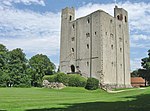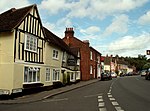Castle Hedingham is a village in northern Essex, England, located four miles west of Halstead and 3 miles southeast of Great Yeldham in the Colne Valley on the ancient road from Colchester, Essex, to Cambridge.
It developed around Hedingham Castle, the ancestral seat of the de Veres, Earls of Oxford. The first earl, Aubrey de Vere III, finished the initial building of the keep and established a Benedictine nunnery, Castle Hedingham Priory, near the castle gates. Hugh de Vere, fourth earl of Oxford, purchased the right to hold a market in the town of the crown in the mid-13th century. He also founded a hospital just outside the gates of the castle around 1250.
The village's main attractions are the well preserved Norman Hedingham Castle, the Colne Valley Railway, Kirby Hall and its many timber-framed medieval buildings.
The church of St. Nicholas is late Norman and Gothic, building having commenced around 1180. The fine double hammerbeam roof is attributed to Thomas Loveday, who was responsible for work on St John's College, Cambridge. Its Romanesque wheel window and cemetery cross are remnants of the Norman church.
The church has a ring of 6 bells. https://dove.cccbr.org.uk/detail.php?tower=11865
The village was served by Sible and Castle Hedingham railway station which was opened by Colne Valley & Halstead Railway Company in 1867. The station closed in 1964 and was dismantled and rebuilt in 1974 on a new site to the north west of the village by the Colne Valley Railway Preservation Society.
Castle Hedingham Pottery was an art pottery studio run by Edward Bingham at Castle Hedingham from about 1864 until 1901.








